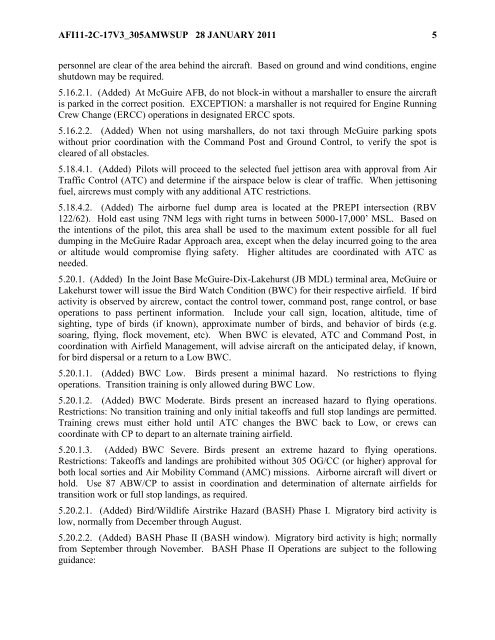BY ORDER OF THE COMMANDER 305TH AIR MOBILITY WING ...
BY ORDER OF THE COMMANDER 305TH AIR MOBILITY WING ...
BY ORDER OF THE COMMANDER 305TH AIR MOBILITY WING ...
You also want an ePaper? Increase the reach of your titles
YUMPU automatically turns print PDFs into web optimized ePapers that Google loves.
AFI11-2C-17V3_305AMWSUP 28 JANUARY 2011 5<br />
personnel are clear of the area behind the aircraft. Based on ground and wind conditions, engine<br />
shutdown may be required.<br />
5.16.2.1. (Added) At McGuire AFB, do not block-in without a marshaller to ensure the aircraft<br />
is parked in the correct position. EXCEPTION: a marshaller is not required for Engine Running<br />
Crew Change (ERCC) operations in designated ERCC spots.<br />
5.16.2.2. (Added) When not using marshallers, do not taxi through McGuire parking spots<br />
without prior coordination with the Command Post and Ground Control, to verify the spot is<br />
cleared of all obstacles.<br />
5.18.4.1. (Added) Pilots will proceed to the selected fuel jettison area with approval from Air<br />
Traffic Control (ATC) and determine if the airspace below is clear of traffic. When jettisoning<br />
fuel, aircrews must comply with any additional ATC restrictions.<br />
5.18.4.2. (Added) The airborne fuel dump area is located at the PREPI intersection (RBV<br />
122/62). Hold east using 7NM legs with right turns in between 5000-17,000’ MSL. Based on<br />
the intentions of the pilot, this area shall be used to the maximum extent possible for all fuel<br />
dumping in the McGuire Radar Approach area, except when the delay incurred going to the area<br />
or altitude would compromise flying safety. Higher altitudes are coordinated with ATC as<br />
needed.<br />
5.20.1. (Added) In the Joint Base McGuire-Dix-Lakehurst (JB MDL) terminal area, McGuire or<br />
Lakehurst tower will issue the Bird Watch Condition (BWC) for their respective airfield. If bird<br />
activity is observed by aircrew, contact the control tower, command post, range control, or base<br />
operations to pass pertinent information. Include your call sign, location, altitude, time of<br />
sighting, type of birds (if known), approximate number of birds, and behavior of birds (e.g.<br />
soaring, flying, flock movement, etc). When BWC is elevated, ATC and Command Post, in<br />
coordination with Airfield Management, will advise aircraft on the anticipated delay, if known,<br />
for bird dispersal or a return to a Low BWC.<br />
5.20.1.1. (Added) BWC Low. Birds present a minimal hazard. No restrictions to flying<br />
operations. Transition training is only allowed during BWC Low.<br />
5.20.1.2. (Added) BWC Moderate. Birds present an increased hazard to flying operations.<br />
Restrictions: No transition training and only initial takeoffs and full stop landings are permitted.<br />
Training crews must either hold until ATC changes the BWC back to Low, or crews can<br />
coordinate with CP to depart to an alternate training airfield.<br />
5.20.1.3. (Added) BWC Severe. Birds present an extreme hazard to flying operations.<br />
Restrictions: Takeoffs and landings are prohibited without 305 OG/CC (or higher) approval for<br />
both local sorties and Air Mobility Command (AMC) missions. Airborne aircraft will divert or<br />
hold. Use 87 ABW/CP to assist in coordination and determination of alternate airfields for<br />
transition work or full stop landings, as required.<br />
5.20.2.1. (Added) Bird/Wildlife Airstrike Hazard (BASH) Phase I. Migratory bird activity is<br />
low, normally from December through August.<br />
5.20.2.2. (Added) BASH Phase II (BASH window). Migratory bird activity is high; normally<br />
from September through November. BASH Phase II Operations are subject to the following<br />
guidance:
















